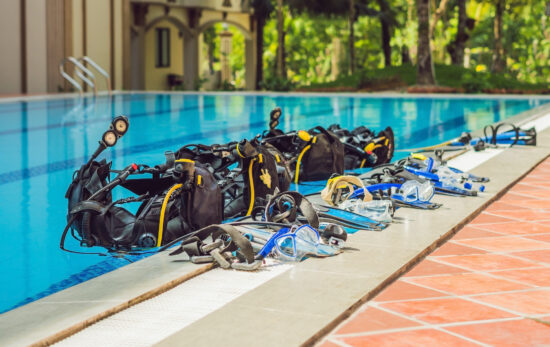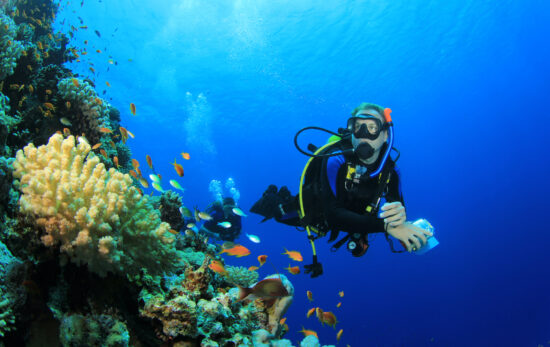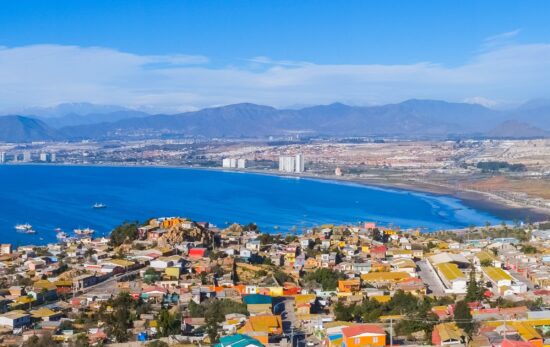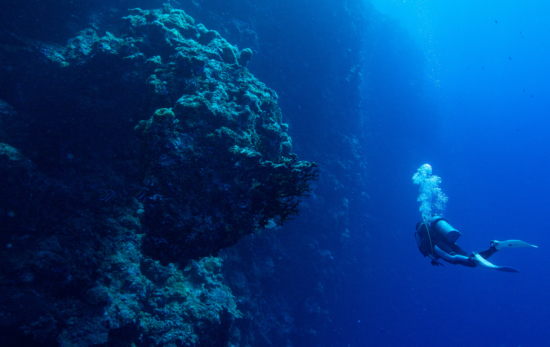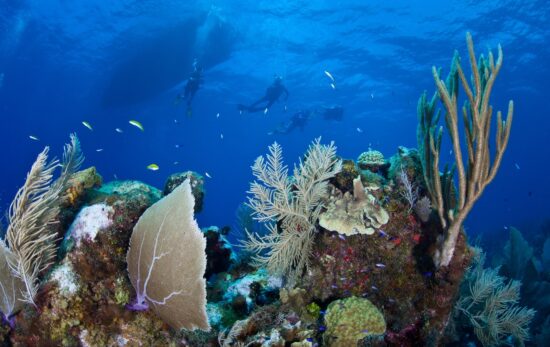The Galapagos Islands are located 600 miles (1,000 kilometers) west of Ecuador and are at the convergence of five different ocean currents, attracting over 3,000 marine species. This makes these islands home to some of the most magnificent marine life, and many divers dream of being face-to-face with such extraordinary species. Divers from all over the world travel to the Galapagos Islands, making it a true hotspot.
There are two distinct seasons, each of which boasts a different set of marine life. The warm season, December through May, is the best time for schooling hammerheads and other sharks species. This time of year is also great for spotting various ray species, including manta rays. The cold season, July through December, is best for whale sharks, penguins, and mola mola. The Galapagos Islands have everything from underwater volcanic structures to beautiful coral reefs.
No matter what your experience level is, the Galapagos Islands has something for everyone. If you’re planning on diving in the Galapagos, be sure to add these 14 dive sites to your scuba diving bucket list.
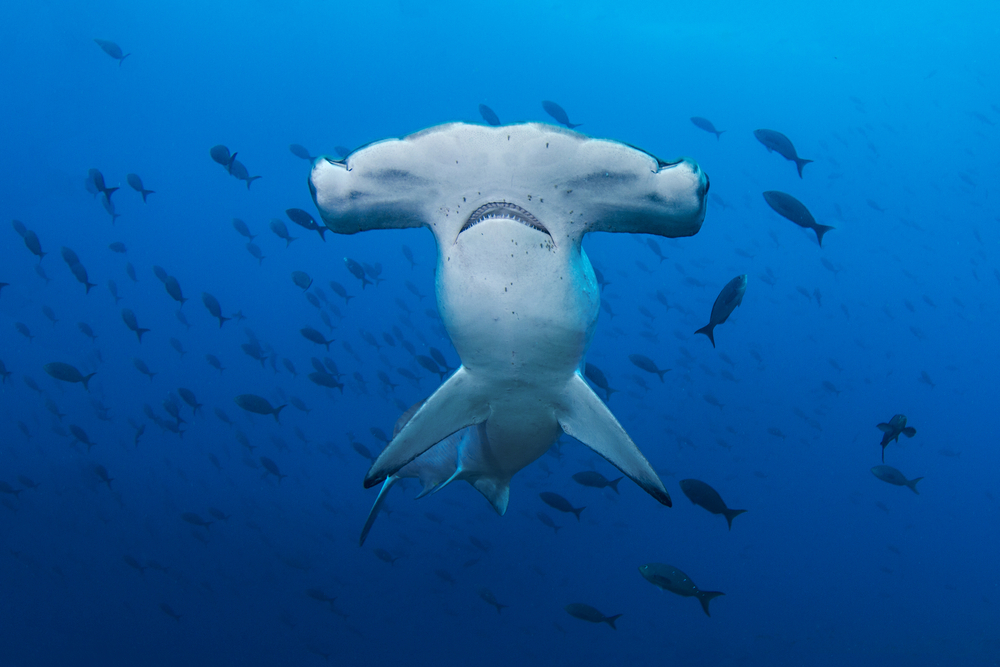
1. Darwin’s Arch
On the far outer reaches of the archipelago is an island called Darwin Island. This island is home to one of the most famous dive sites known as Darwin’s Arch. Despite the fact that the actual rock arch landmark collapsed in 2021, Darwin’s Arch is one of the prime destinations every liveaboard aims to visit during dive expeditions in the Galapagos. Divers usually spot sea turtles, dolphins, eagle rays and whale sharks (June to November) here. The real showstopper are the huge number of sharks brought in by the strong currents. Divers will most likely see large shivers of hammerhead sharks, silky sharks, blacktip sharks and Galapagos sharks. This site is most famous for the large schooling of hammerheads, so be sure to have your cameras ready!
- Recommended Level: Advanced
- Featured Creatures: Hammerheads, Galapagos Sharks, Silky Sharks, Blacktip Sharks and Whale Sharks
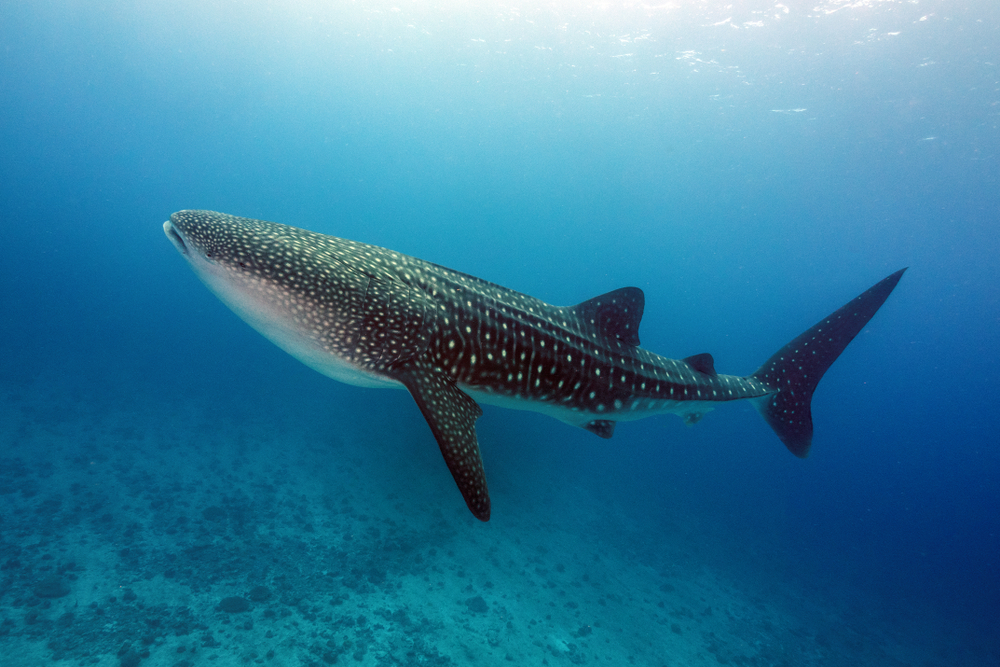
2. Shark Bay
Shark Point is where divers go to fulfill their dreams. Here, it’s also possible to see large shivers of hammerhead sharks and Galapagos sharks. Strong currents, surges, and other unpredictable environmental changes, mean this dive site is for experienced divers only. It’s important to note that the only way to access this dive site is by taking part in a liveaboard expedition.
- Recommended Level: Advanced
- Featured Creatures: Whale Sharks
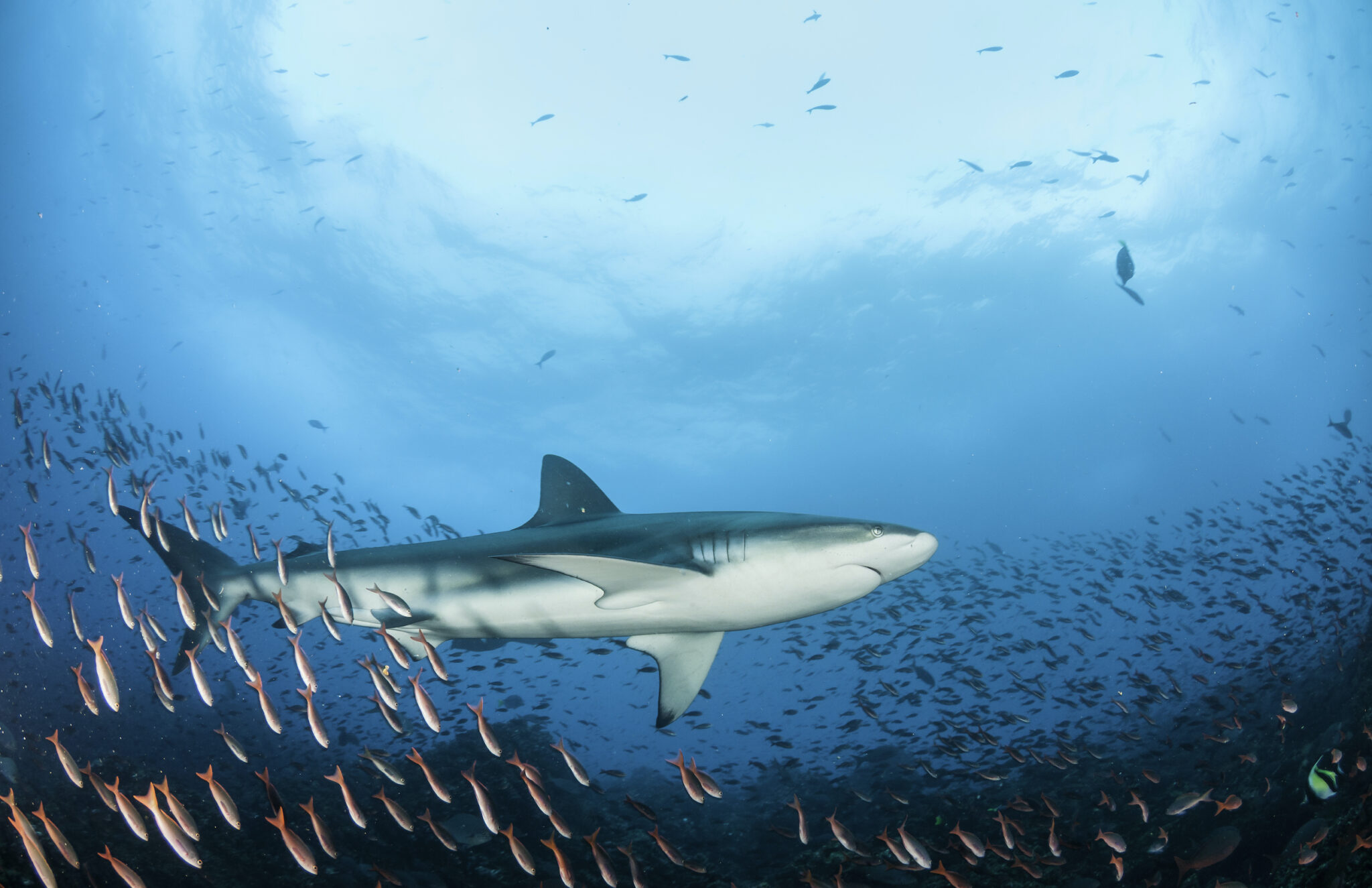
3. Gordon Rocks
One of the best dive sites in the central islands, Gordon Rocks, is the eroded crater of a submerged cone on the northeast side of Santa Cruz Island. You can expect to see a lot of marine life during dives here, but most divers go to Gordon Rocks to experience what it’s like to be around large shivers of hammerhead sharks. Strong currents bring dozens of these predators into a relatively confined area, making this a great place to get up close and personal with the sharks.
- Recommended Level: Intermediate to Advanced
- Featured Creatures: Hammerhead Sharks
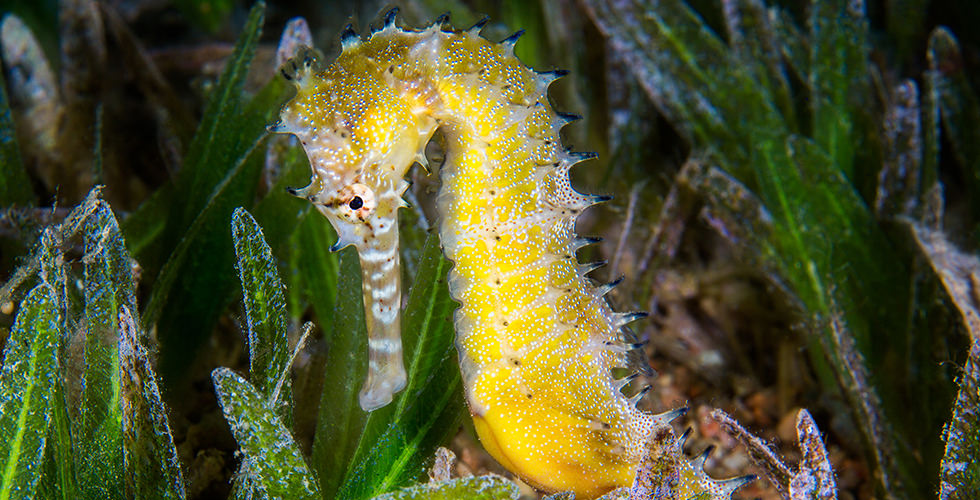
4. Camaño Islet
Situated off the coast of Santa Cruz Island, Camaño Islet is a great option for beginners who also want to enjoy the underwater wonders of the Galapagos. If you plan on visiting Camaño Islet, expect to see groupers, batfish, sea lions, and seahorses. Divers might even spot Galapagos marine iguanas searching for food under the surface. The dive profile at Camaño Islet typically maxes out at 33-50 feet (10-15 meters) with great visibility, making it a nice and easy dive.
- Recommended Level: Beginner
- Featured Creatures: Seahorses, Sea Lions, Batfish and Grouper
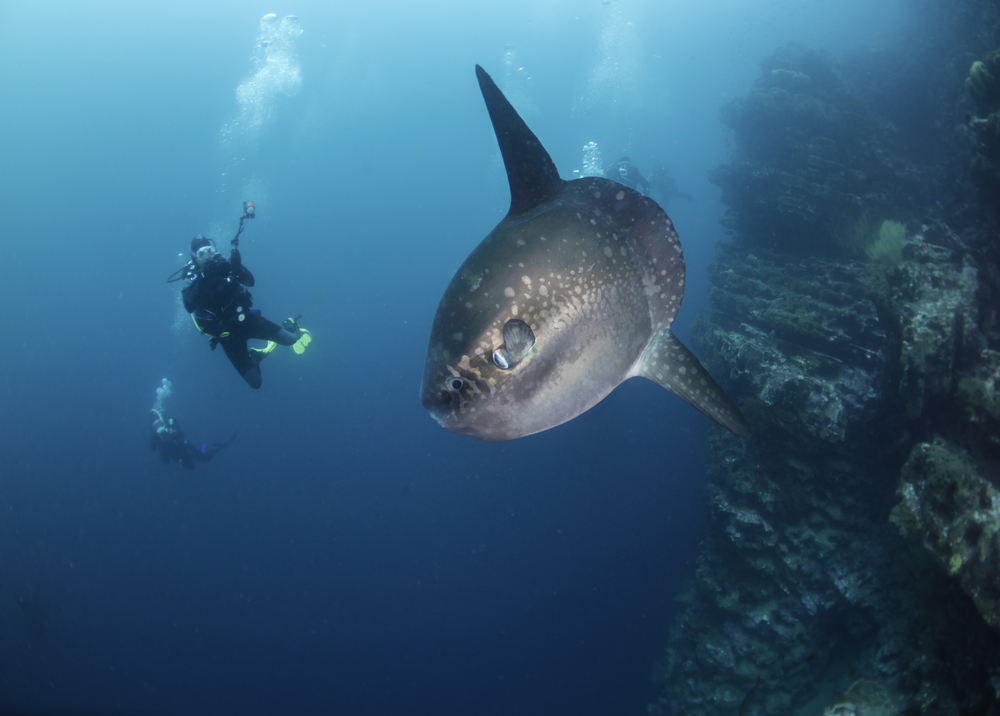
5. Punta Vicente Roca
Punta Vicente Roca is a sloping wall with several small caves off of Isabela Island. This site reaches a max depth of 88 feet (27 meters) with better conditions found in the cold water below 40 feet (12 meters). Punta Vicente Roca has an amazing wall where divers will most likely spot different species of invertebrates along the wall, including frogfish and seahorses. On the other side of the wall, it opens up to the beautiful deep blue. The real attraction here are the ocean sunfish! Ocean sunfish, also known as Mola mola, are often seen swimming along the outside of the wall, where they come to be cleaned. On your safety stop, look out for diving penguins and playful sea lions. Every minute is an adventure at Punta Vicente Roca.
- Recommended Level: Intermediate
- Featured Creatures: Sunfish, seahorses and Galapagos bullheadsharks
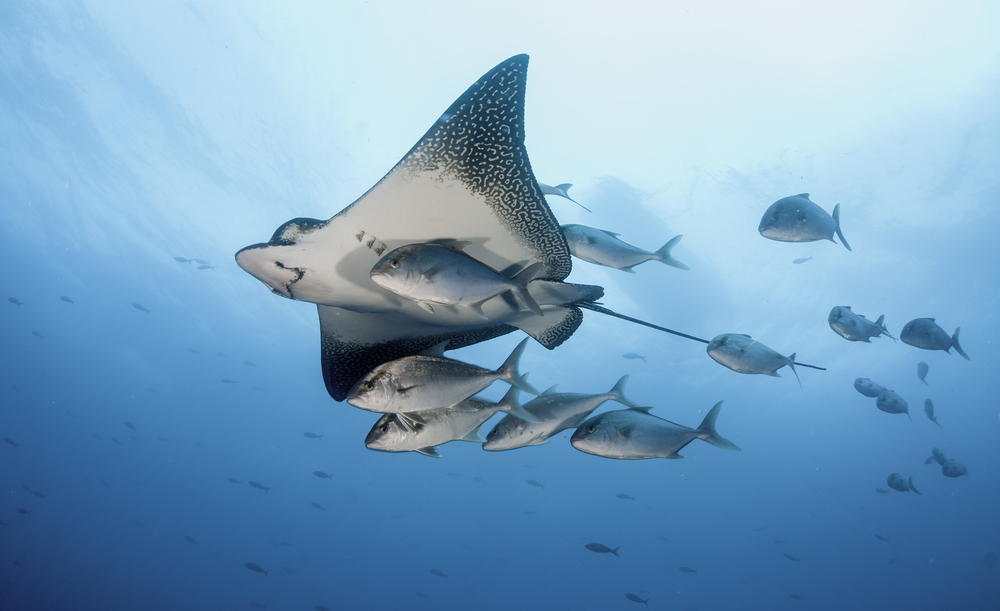
6. North Seymour Ocean Side
There’s so much to see at North Seymour, so you might want to stick around for more than one dive! The gradual rocky slope that extends from the north of Santa Cruz Island provides the perfect habitat for Yellowtail Grunts, Bluestripe Snapper, and Salemas. Divers can also spot large groups of eagle rays, marble rays, manta rays, and stingrays. Swimming around in the deep blue, visitors might also get to see jacks and hammerhead sharks. Blue-Footed Boobies are very common in this area. Occasionally, they will dive in and swim down to catch a meal. There’s never a dull moment while exploring this area of the Galapagos.
- Recommended Level: Beginner
- Featured Creatures: Eagle Rays and Blue-Footed Boobies
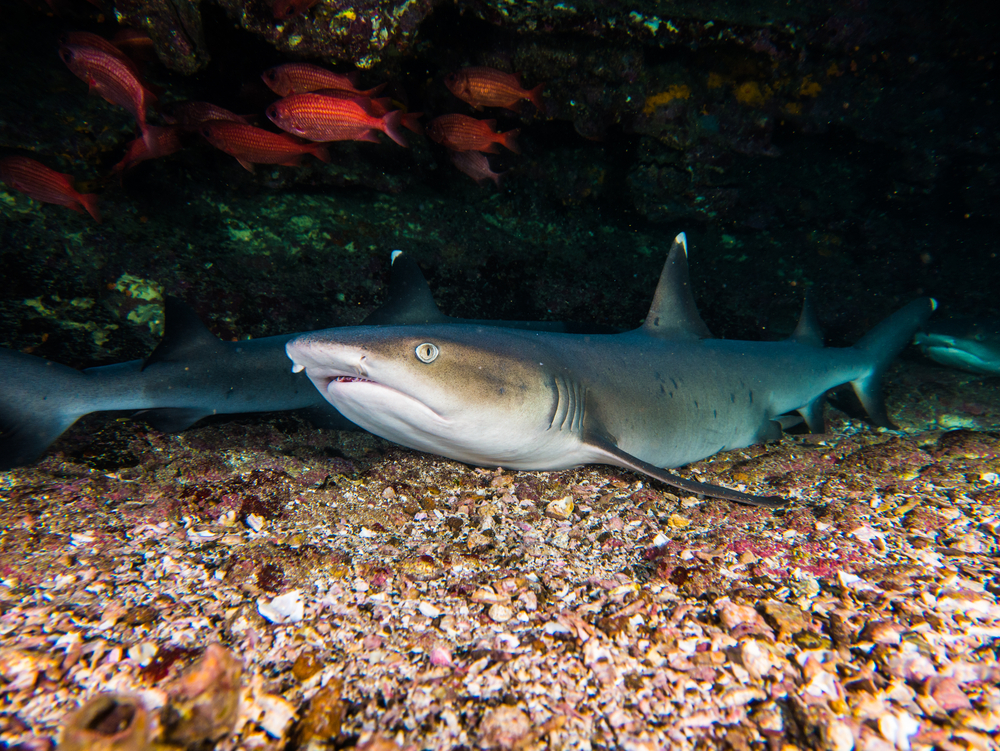
7. Cousins Rock
Cousins Rock might be considered the best intermediate dive site in the Galapagos. This dive site is located off the northeast coast of Santiago Island. It offers terraced steps that drop down to a sandy bottom at 130 feet (40 meters). The steps are covered in black corals, which make an excellent habitat for the Pacific Seahorse. White-tipped reef sharks, sea turtles and moray eels like to use overhangs created by these “steps” as little hideouts. That’s not all! Divers here should watch out for barracudas, manta rays, and hammerhead sharks swimming in the deep blue.
- Recommended Level: Intermediate
- Featured Creatures: Pacific Seahorse, White-Tipped Reef Sharks and Sea Turtles
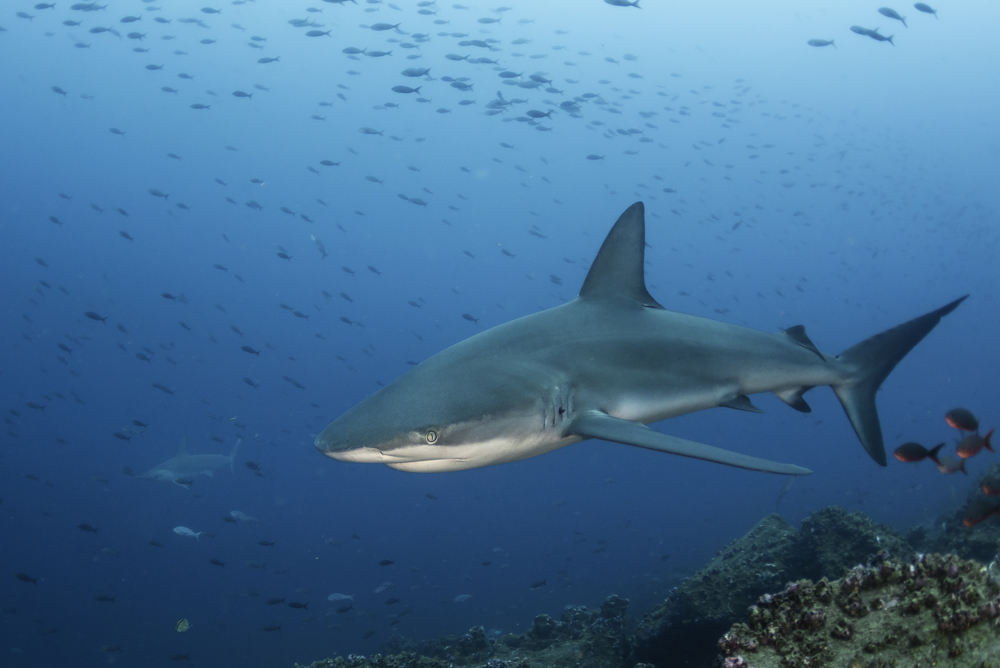
8. Roca Redonda
Famous for its streams of natural gas bubbles, also called fumaroles, Roca Redonda is the best site in the Galapagos for experiencing the archipelago’s volcanic nature. After a challenging entry full of heavy surge, divers pull themselves along the rocks to a sandy patch where the hot bubbles are released from the earth below. Colorful nudibranchs seemingly love the environment as well, so make sure you don’t miss their beautiful unique patterns. As divers start ascending, they should be sure to save some time for the Galapagos sharks. Several of these amazing marine species will most likely be hanging out near the area where divers usually complete their safety stop.
- Recommended Level: Advanced
- Featured Creatures: Nudibranchs and Galapagos Sharks
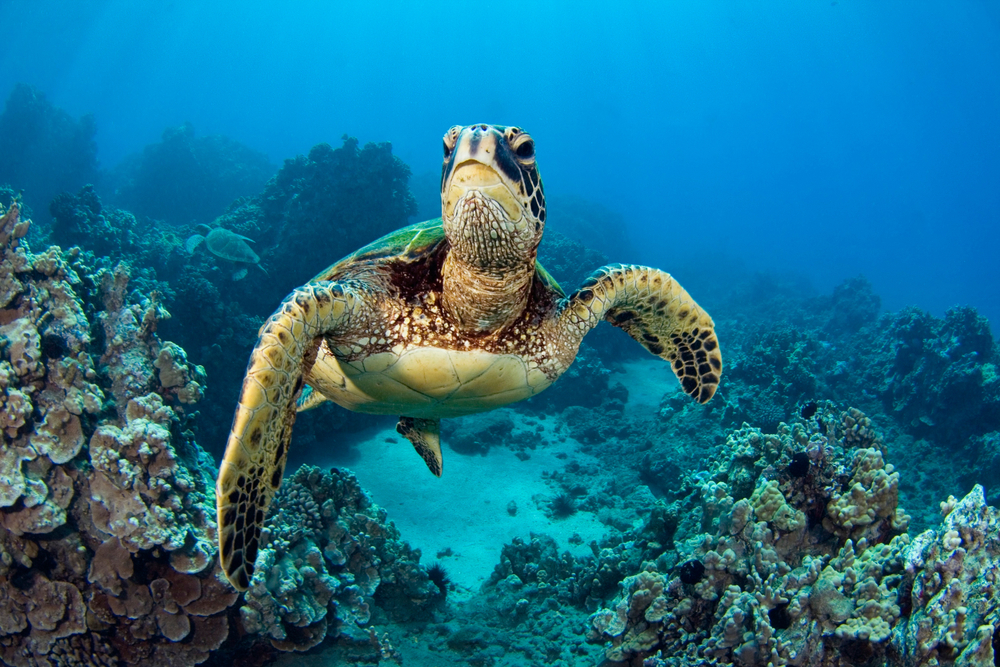
9. Bartholomew Point
With a combination of amazing rock formations and magnificent marine species, Bartholomew Point should be on any list of the best dive sites in the Galapagos Islands. Lucky divers can even spot unbelievable bait balls here. These bait balls attract Galapagos penguins (the only penguin found north of the Equator), sea lions, pelagic fish, white-tipped reef sharks and a variety of rays. When not in the middle of a bait ball, divers might also see sea turtles, a variety of reef fish, manta rays and curious hammerheads in the deep blue. There are moderate to strong currents here; therefore, this dive site is reserved for intermediate to advanced divers.
- Recommended Level: Intermediate to Advanced
- Featured Creatures: Galapagos Penguins and White-Tipped Reef Sharks
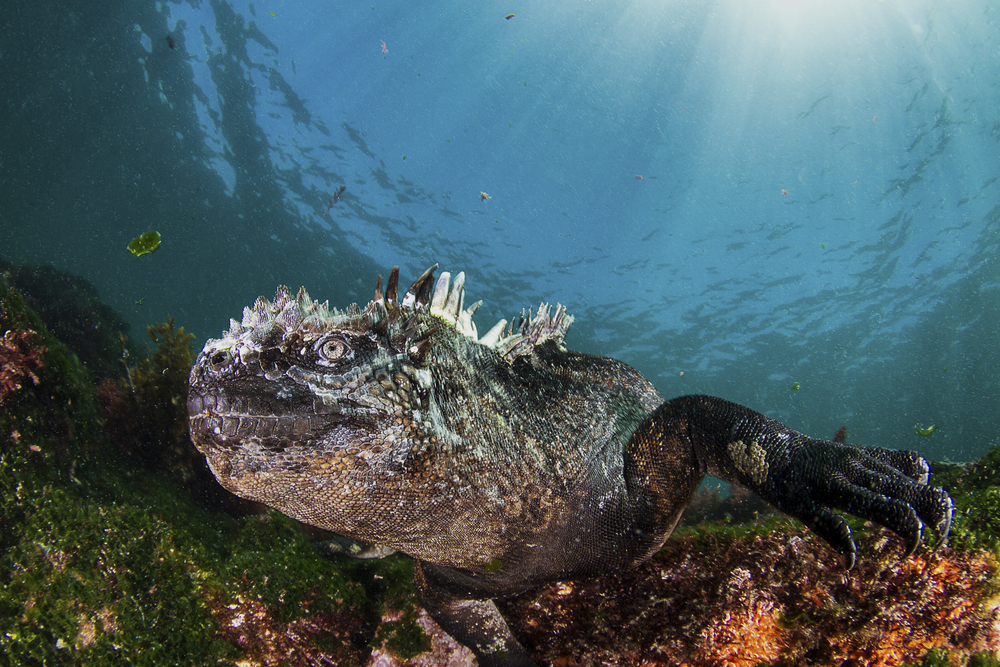
10. Kicker Rock
Kicker Rock is a very popular dive site in the Galapagos. There is a diverse variety of wildlife at Kicker Rock, so it’s well worth a visit. Not only is this dive site great for scuba divers, but snorkelers are welcome here, too! This dive site is located off the coast of San Cristobal Island. Diving down between the two rocks, divers can see sea turtles, large rays, wrasse, surgeonfish, angelfish, Galapagos sharks and even hammerhead sharks in deeper waters. Marine iguanas enjoy hunting in this area, so keep your eyes peeled in case one swims by. Most land-based operations will visit the playful sea lion colony at Lobos Island, which makes for a wonderful day of underwater adventures!
- Recommended Level: Beginner+
- Featured Creatures: Marine Iguanas and Sea Lions
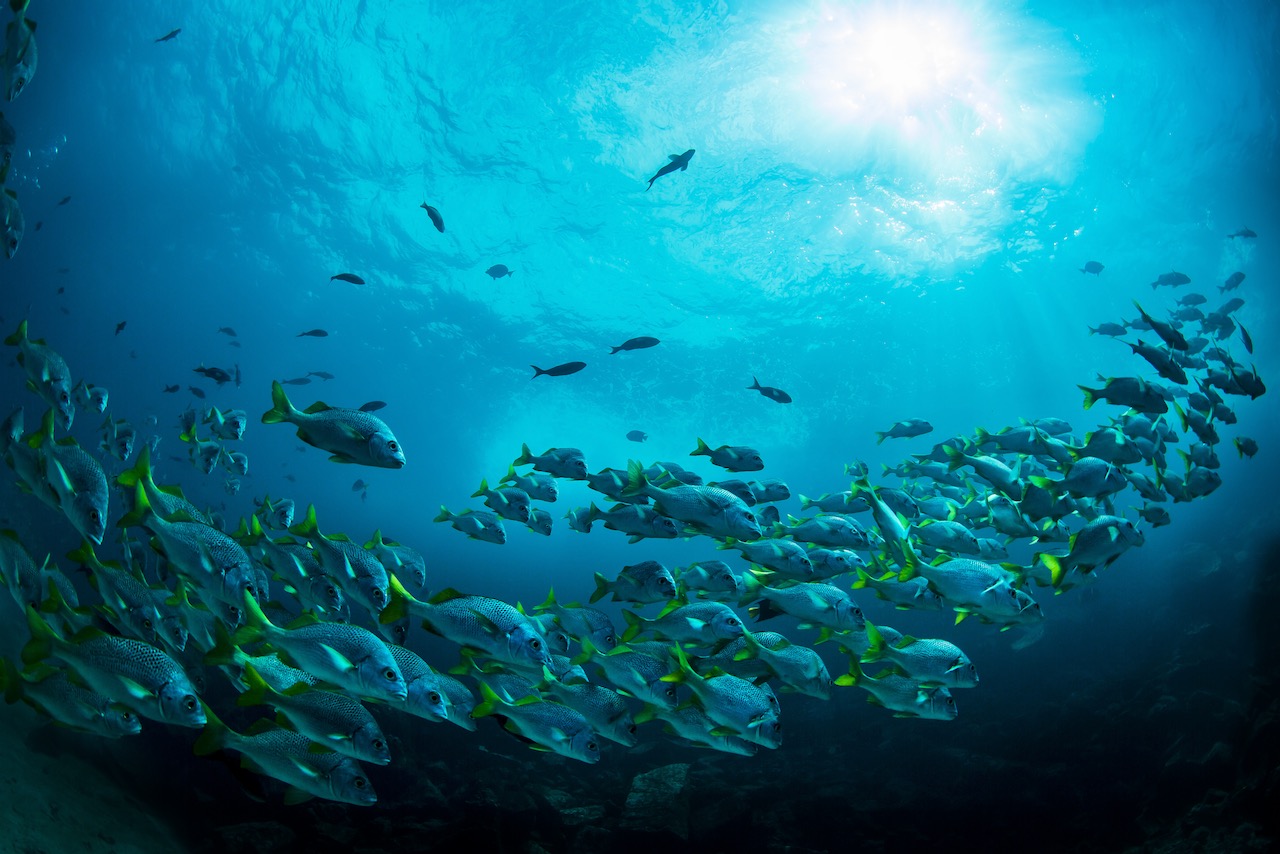
11. Daphne Manor
This dive site allows less experienced divers to enjoy the true beauty of the Galapagos. Daphne Manor features a wall that is filled with vibrant corals, sponges, and fan structures. These unusual topographic features provide wonderful hiding spaces for masters of camouflage, like eels, invertebrates, and more. Make sure to bring a light of some kind to see what critters you can find, but be sure to always respect their space. The current is very smooth, making it suitable for all dive levels. On the other side of this wall, it opens up to the deep blue. Be sure to keep your eyes out for other marine life passing through this area. Daphne Manor has a magnificent array of shark species, rays, and pelagic fish.
- Recommended Level: Beginner to Advanced (great for all skill levels)
- Featured Creatures: Great array of sharks and pelagic fish
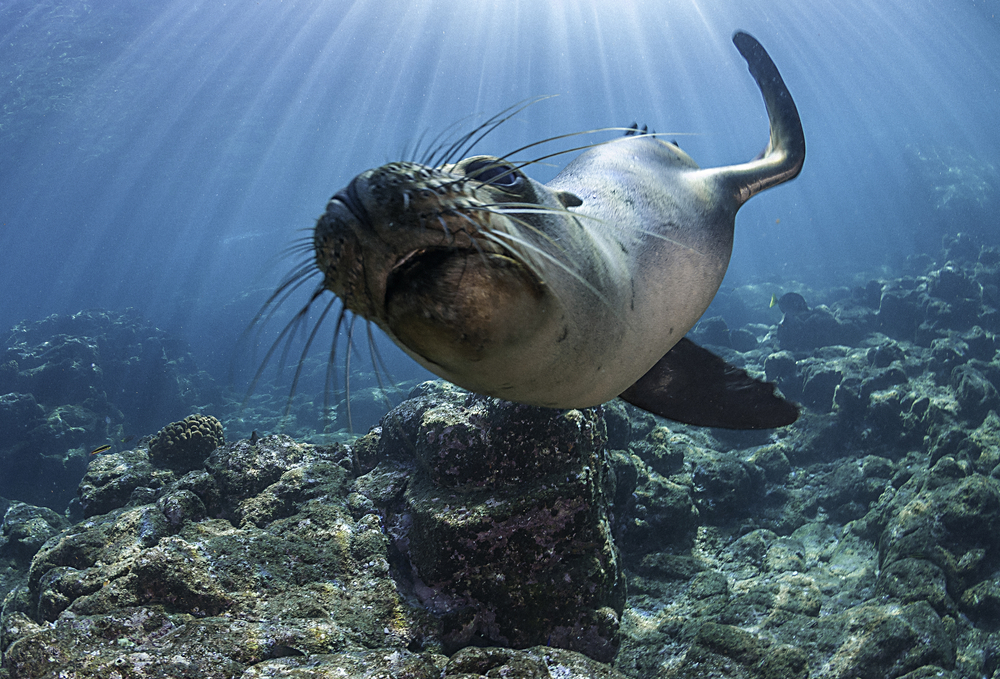
12. Whale Rock
You can access Whale Rock by boat off of San Cristobal Island. This rock formation makes the dive a very interesting dive site for experienced divers. Large schools of fish congregate at Whale Rock and enjoy swimming with the currents. Grunts, snapper, and other pelagic species are commonly spotted here. If you’re looking to have unforgettable encounters with various rays and sea turtles, make sure you add Whale Rock to your list! Many divers prefer to drift dive here due to Whale Rock’s currents. These currents are usually very mild to moderate, making it an easy drift dive.
- Recommended Level: Intermediate to Advanced
- Featured Creatures: Massive schools of fish and sea turtles
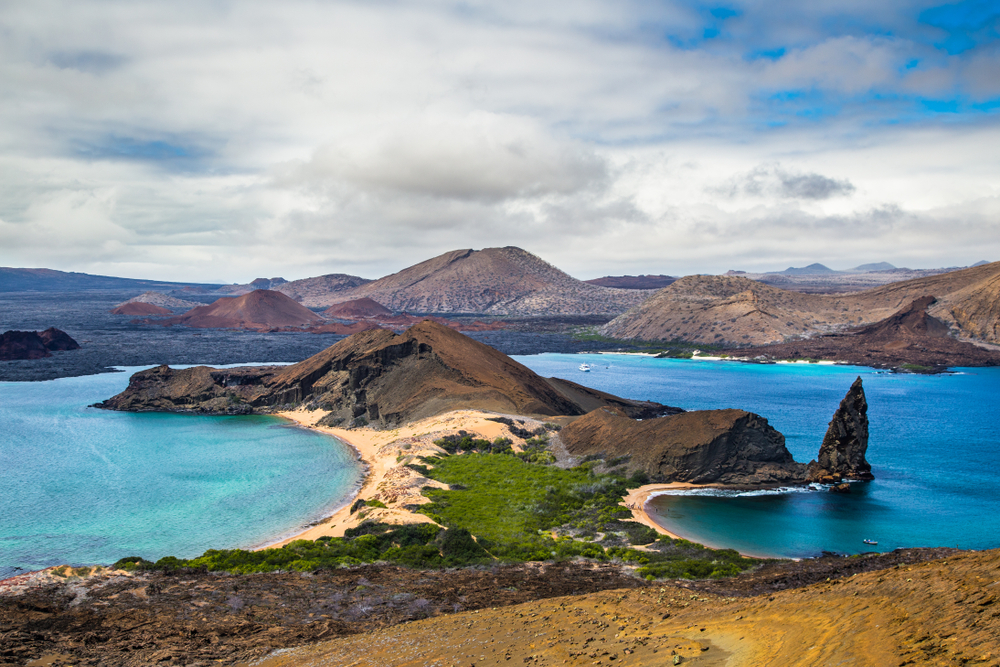
The Galapagos is a Bucket List Destination
Diving in the Galapagos unquestionably belongs on your bucket list. These islands offer an experience unlike any other. The mesmerizing underwater landscapes and diverse marine life will leave you awe-struck. Travel to the Galapagos if you want the chance to witness graceful sea turtles gliding past passive hammerhead sharks and colorful schools of fish in the distance.
The mysterious allure of the Galapagos Islands, where evolution has been studied for decades, adds intrigue to every dive. Being surrounded by some of the most incredible marine creatures, guided by PADI Divemasters, fosters an unmatched sense of tranquility and amazement. Embracing this underwater paradise isn’t just a privilege; it’s an unforgettable adventure that will leave you with lifelong memories.
